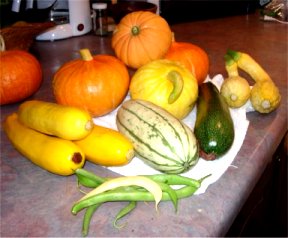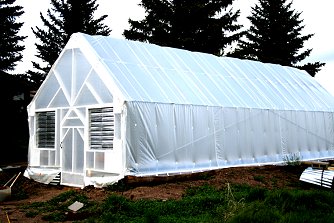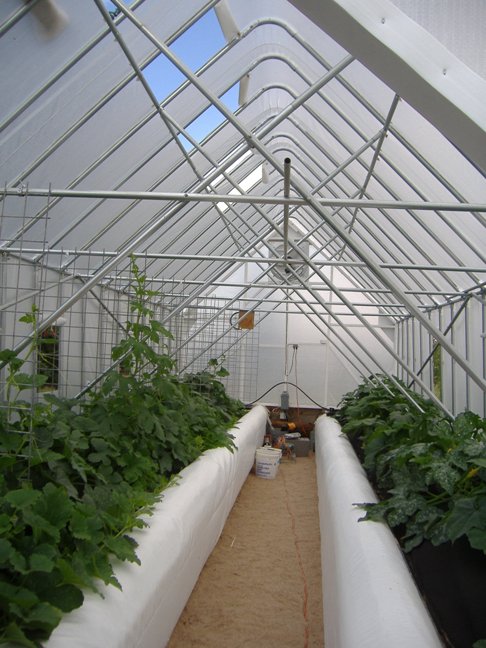
In the first of this two article series, I suggested that a focus on objectives is a good way to help direct and manage our vegetable growing affairs – be they commercial or simply a hobby of ours. It seems only fair to share some of my specific objectives with readers, as they are the key to how I manage my vegetable gardening activities. Examining these might give you some ideas as to how your vegetable gardening plans could be tempered.
As one might expect, each of my objectives can stand alone, but they exist as a set in my management plan. Each objective supports the others in some respect, and in some cases gives birth to others. In addition, each one is influenced to some extent by my particular situation out on the wind-swept prairie of southeastern Wyoming.
The following items are what ranks high when I engage in management by objectives for my vegetable gardening activities. You’ll quickly see that my objectives suggest not only activities, but tools and resources to help accomplish my general goals.
Objective #1: Kiss the Grocery Store Goodbye
Well, that’s not exactly how folks in the boardroom might phrase a business objective, but that’s how I do it. In our oil-based economy, the price of vegetables has risen sharply, keeping pace with the cost of the petroleum products that are used to fertilize, treat, process and transport our food. I think it’s ridiculous to pay more per pound for vegetables than meat. How can a handful of collard greens cost a dollar or more? How is it that beets sell for nearly 75 cents each? And, as if our produce isn’t expensive enough, if you want organic food, you’ll pay even more.
In order to replace the grocery store, I need to create a year round harvest with wide variety, and I need produce that can hang in there during cold weather. It will also have to be conducive to canning, freezing, drying, cured storage and cold storage. It also means that I’ll need high yields despite challenging weather conditions that include semi-arid conditions, drying winds and below zero temperatures.
In support of this key objective, I need to grow:
- Crops that are cold hardy, including those that can over-winter underground so the season is extended.
- Cultivars that can be succession planted and succession harvested to provide a continuous production of food.
- Vegetables that are conducive to cellar storage.
- Produce that gives me large yields for the space it requires.
- Plants that are reliable in terms of germination and production.
- Variety and quality that makes me glad I don’t shop for produce at the grocery store.
Objective #2: Proper Protection from the Elements
Here in the Cheyenne area, we’re known for recurring hail in the spring and summer, 80 mile per hour winds in the winter, summers with weeks and even months without rain, and a short growing season. We’ve seen snow every month of the year except August, and frequently our first heavy snows occur in late September. Therefore, greenhouses are essential to prevent damage and desiccation, and to provide a reasonable growing season for those of us trying to eliminate the grocery store.

Greenhouses can offer at least double the yields of crops grown in open sun garden beds. They not only repel hail, but keep the drying winds at bay and extend our growing season by at least one month on either end of the summer – without any extra effort or added heat. When buttoned up in the winter, cold hardy crops can make it until spring with good planning, and a little care and luck.
I experiment with various styles of greenhouses, and use woven poly to provide proper strength and hail resistance. My current greenhouse styles include sunken walkway, Quonset hut with ground level planting, and converted shed with raised beds. I plan to experiment with PVC and daylight basement style greenhouses, and sunken cold frames and multiple layer glazing to find which is most cost-effective and conducive to growing and keeping produce for an early and extended harvest.
Objective #3: Maximize Use of Space
Although I have plenty of space for things at my little ranchette called “Best of Both Worlds,” I’m limited in the space I have inside my greenhouses. That means I have to make maximum use of that space without over-crowding. One way I address this is to plant high yield crops, the other way is to grow vertically instead of horizontally.

Vertical vegetable gardening means trellises and cages that support winter squash, peas, pole beans, cucumbers, Malabar spinach, tomatoes and other crops that like to climb. It not only makes it easier to walk around in the greenhouses, but it makes for easier and cleaner harvesting as well. With many fruits and vegetables up off of the soil, it’s easier to spot them and they don’t need much rinsing before they’re ready for the salad bowl or steamer.
Growing vertically also provides ideal candidates for the north side of the greenhouse. When I plan my plantings, I simply start with the north side with taller plants and work my way to the southern side with crops that have a short growth habit like beets, kohlrabi and Swiss chard.
Sometimes we tend to think too much in terms of horizontal spacing, so having “vertical growth” as an objective by itself is probably worthwhile. In my sunken pathway greenhouse, I have numerous cross-support members that add rigidity to the structure and provide a perfect pathway for winter squash to grow overhead instead of taking up room in the deep raised beds on either side of the pathway. I try to think vertical as there is much more room above than there is when we focus on simply spreading out.
Objective #4: Make Use of the Sun
I’ve heard people talk about a solar greenhouse. Okay, I thought they were all solar in nature. After all, it captures the sun’s rays and turns them into useful heat. Wouldn’t it be great if we could bottle or can that heat and use it when the sun isn’t shining? Well, that exactly what this objective has led me to do. Bottling and canning take two forms; passive and active solar capture.
In the passive mode, my drum storage and raised beds provide a good way to modify the temperature swings that a greenhouse can see from daytime to nighttime. It’s a relatively simple business of painting things black that face the sun and painting them white on the other side. Solar energy requires a bit of knowledge with respect to reflectivity, absorption and emissivity, but it’s nothing too scientific to grasp with a little study, careful thinking and a little planning.
In addition to passive solar heating, I also actively store the sun’s energy in bottles – drums and tanks to be exact. Using a solar water heater, I pump water through the collector during daylight hours and it heats up water stored in a tank beneath the floor of the greenhouse. More importantly, this tank feeds piping buried beneath the surface of the soil, so the entire mass of moist soil beneath the greenhouse becomes a huge “thermal battery” that is charged during the day and slowly discharged at night.
What we need to remember is that our plants care more about soil temperature than they do about air temperature, and my in-ground solar heating system accommodates their needs just fine. Instead of trying to use warm air to heat the soil, I use warm soil to heat the air. It requires a little energy to pump the water, but it’s very little energy indeed – especially when compared to the heat that is provided by the sun – and it helps warm the soil like nothing else can.
Objective #5: Healthy and Organic Produce
What needs to be said about healthy and organic produce that hasn’t already been said? Don’t we all want more control over what goes into and ends up on the food we consume? Moreover, haven’t we learned that prematurely harvested food that is artificially grown with the equivalent of plant steroids isn’t nearly as healthy as ripe fruits and vegetables that are grown without “help” from poisons that come out of a laboratory?
Staying consistent with this objective means that I need to keep learning more about composting, natural soil amendments, crop rotation, and companion planting and knowing when food is at its best for harvest. It also means I need to be mindful that my own harvesting, processing and storage techniques aren’t harming the beneficial effects of what I grow.
I have no interest in a government seal of approval that suggests that I meet some bureaucrat’s standard of what passes for “organic.” I’m interested in setting my own standard for me and my production, as this will support any future efforts in the marketplace that could distinguish me from others who provide organic foods.
Objective #6: Endless Bounty for My Fine Feathered Friends
Oddly enough, my vegetable gardening isn’t all focused on me and my family. One of my management objectives is to provide food for my flock of layers and meat birds. Many greens, grasses, root crops and summer squash are favorites of chickens, ducks and turkeys. Some of these can be grown in greenhouses, but most of it will be grown outdoors but inside fenced enclosures to promote a type of “free range” feeding without the threat of predators.
Lessons learned from my greenhouse gardening will help me select cultivars that produce high yields, regenerate after harvesting, and can withstand a wide range of weather conditions. Success in this area will help eliminate most of the food requirements for my small animals, thus furthering my quest to eliminate the grocery store.
Objective #7: Indoor Perma-culture
Much of what we plant has a relatively short life-cycle. Radishes are finished within about 45 days, tomatoes in 120 days, and peas in 60 days or thereabouts. I’m making room in my greenhouses for cultivars that will be permanent in nature – grapes, berries, asparagus, artichokes, rhubarb, and even miniature fruit trees. Instead of planting each year, I’ll start redirecting my efforts to coaxing food out of greenhouse residents that are permanent and don’t require planting each season.
Focusing on this objective will create more diversity in what I grow – fruits instead of just vegetables. It will also make it a bit easier to plan my garden as some of the residents and their needs and behavior will be well known after years of experience. I’ll also be able to create greater success by using protection from the greenhouse to help spring blossoms make it through below freezing temperatures in June, and hail that visits us just about the time the fruit is ready to set.
In addition to variety in terms of food, having permanent residents will also add a bit more interest to my greenhouse efforts. Food isn’t the only thing we need to keep fresh – it helps to keep our interest in our efforts just as fresh as the food we seek.
Objective #8: Groundwork for Commercial Operations
As we continue to see how our food supply becomes more controlled and contaminated due to centralization, the “slow food” and local food movements pick up steam. It’s possible that some of my efforts could enable me to be poised for success in the marketplace if I choose to pursue that avenue for income. There is no sense jumping into something with both feet when it makes more sense to gain experience and then go commercial.
Much of my efforts are designed to give me high yields, reliable production, quality produce, and a much broader growing and harvesting season – characteristics that will be in demand in the marketplace. So, you might say that this objective comes along for the ride. Nevertheless, I keep it a formal part of my management plan so I’m ready when the time is right to turn my self sufficiency into a viable revenue stream.
Much of what happens in the future will be determined by how much government gets involved in our lives. For my money, I’m taking control of my food supply, and this may very well pave a way for me to contribute to others who want whole and organic foods. I keep an eye on this objective as I want to be prepared to strike when the iron is hot and I know that it’s a good time to get involved.
The Objectives that Count
The most important objectives are those that you embrace. I hope a look at mine have given you some food for thought. Whether you have specific objectives written in a plan, or they’re just floating around in your memory banks somewhere, having them is a good starting point. Prioritize your objectives and you’ll start to see how the resources you invest in and the activities you engage in can be better focused to assure successful achievement of what you consider to be your most important objectives for vegetable gardening.
Clair Schwan is an avid vegetable gardener who considers his gardens to be important assets. To him, vegetables in the garden are a bit like money in the bank.
Related Articles & Free Email Newsletter
A Plan to Make the Next Growing Season Even More Successful
Active Solar Heating for Greenhouses




Comment here